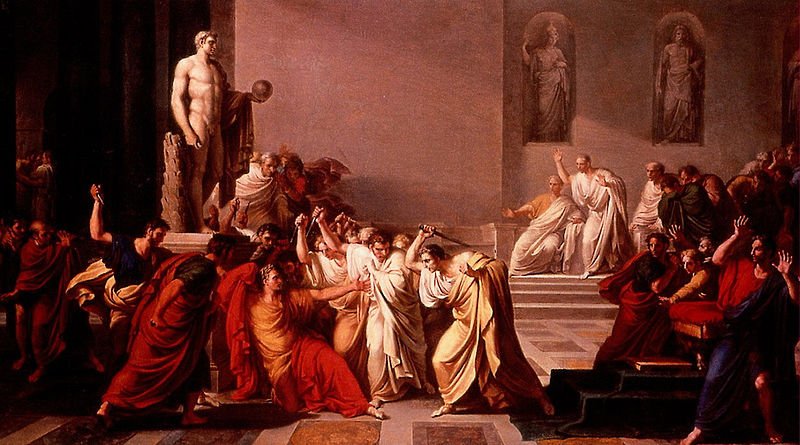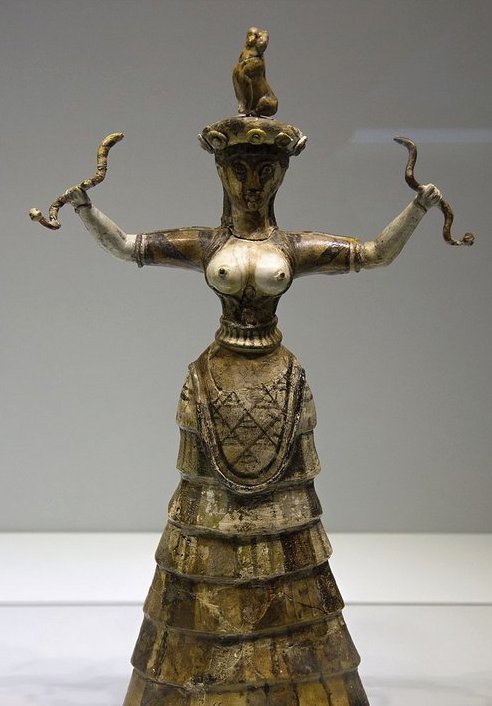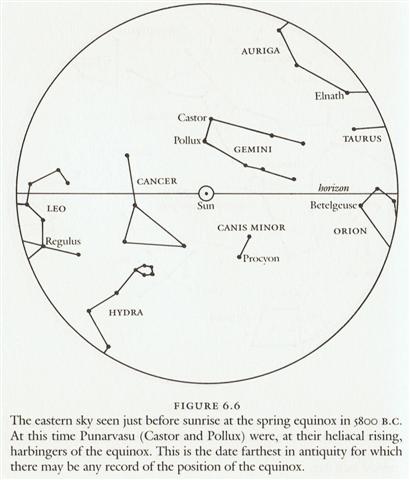Let me first state that March 14 (→ 3.14) is day 31 + 28 + 14 = 73 = 365 / 7. And in the ancient Roman calendar the next day was Idus Martiae:
... The brutes of spring caused the downfall of both Captain Cook and Julius Caesar. We are close to the key myth of mankind, that which explains the regeneration of sun and of growth. Once upon a time at least some people kept the tradition living. I became interested in what really happened at March 15 and reopened Henrikson to find out: Caesar had been forewarned of the threat by the prophet Spurinna, who told him that a great threat was coming at Idus Martiae or just before [i.e. at 3-14]. The day arrived and Caesar was still living, walking to his meeting with the Senate when he happened to encounter Spurinna and told him jokingly that he was still alive. Spurinna calmely answered that the day had yet not ended ...
Halfway through the 3rd month (March), we can deduce, was a 'knee' (tara) - an abrupt change - where the dark winter season was bound to be 'liquidated' so to say by iron daggers (→ Mars). This explains why we have 3-14 in Eb3-14 in parallel with Pa3-14. The product of the diameter of a circle and 3.14 will generate the length of the total circumference. Furthermore, it also casts light on why Eb7-7 is a twin of Eb7-5. For the rule of the Moon in the dark season after the winter solstice will change into a rule of Mars in the middle of the month of March: So we can now perceive why Sb2-8 has the sweet water of Tane at left (the side of the past) and a pair of limbs at right (the side in front).
... During his descent the ancestor still possessed the quality of a water spirit, and his body, though preserving its human appearance, owing to its being that of a regenerated man, was equipped with four flexible limbs like serpents after the pattern of the arms of the Great Nummo.
The ground was rapidly approaching. The ancestor was still standing, his arms in front of him and the hammer and anvil hanging across his limbs. The shock of his final impact on the earth when he came to the end of the rainbow, scattered in a cloud of dust the animals, vegetables and men disposed on the steps. When calm was restored, the smith was still on the roof, standing erect facing towards the north, his tools still in the same position. But in the shock of landing the hammer and the anvil had broken his arms and legs at the level of elbows and knees, which he did not have before. He thus acquired the joints proper to the new human form, which was to spread over the earth and to devote itself to toil ... I suggest the pair of arms with closed fists in Sb2-8 could represent the twins Castor and Pollus in the Gemini constellation, those who initially had stood up at spring equinox, but who nowadays (AD 2023) had the knee of the outstretched leg of Castor (Mebsuta) one hundred days later - i.e. where the planet Mars would be in April 14 (signifcantly day 104 = 59 days after February 14):
... The Mangaians made and flew three kinds of kite which had a unique astronomical significance possibly associated with ceremonies to insure an abundant supply of food from the stars. One kite represented the Pleiades: it was diamond-shaped and had six bunches of feathers attached to the tail. A second type was made with wings and bore three bunches of feathers, symbolizing Orion's Belt. And last but not least, the third type was oval and carried four tufts of feathers to represent the ubiquitous twins, Pipiri, and their iniquitous parents. The inclusion of the twins and their parents and their elevation to an equal footing with the Pleiades and Orion's Belt reveal their importance as seasonal and food-bringing stars ... ... In Hindu legend there was a mother goddess called Aditi, who had seven offspring. She is called 'Mother of the Gods'. Aditi, whose name means 'free, unbounded, infinity' was assigned in the ancient lists of constellations as the regent of the asterism Punarvasu. Punarvasu is dual in form and means 'The Doublegood Pair'. The singular form of this noun is used to refer to the star Pollux. It is not difficult to surmise that the other member of the Doublegood Pair was Castor. Then the constellation Punarvasu is quite equivalent to our Gemini, the Twins. In far antiquity (5800 B.C.) the spring equinoctial point was predicted by the heliacal rising of the Twins (see fig. 6.6) ...
Furthermore, we should remember how in the basic Egyptian myth of Osiris the good king was tricked into a box which was absolutely dark inside; ... The basic myth of dynastic Egypt was that of the death and resurrection of Osiris, the good king, 'fair of face', who was born to the earth-god Geb and sky-goddess Nut. He was born together with his sister-wife, the goddess Isis, during the sacred interval of those five supplementary days that fell between one Egyptian calendric year of 360 days and the next. He and his sister were the first to plant wheat and barley, to gather fruit from trees, and to cultivate the vine, and before their time the races of the world had been savage cannibals. But Osiris's evil brother, Set, whose sister-wife was the goddess Nephtys, was mortally jealous both of his virtue and of his fame, and so, stealthily taking the measure of his good brother's body, he caused a beautifully decorated sarcophagus to be fashioned and on a certain occasion in the palace, when all were drinking and making merry, had it brought into the room and jestingly promised to give it to the one whom it should fit exactly. All tried, but, like the glass slipper of Cinderella, it fitted but one; and when Osiris, the last, laid himself within it, immediately a company of seventy-two conspirators with whom Set had contrived his plot dashed forward, nailed the lid upon the sarcophagus, soldered it with molten lead, and flung it into the Nile, down which it floated to the sea ...
|














